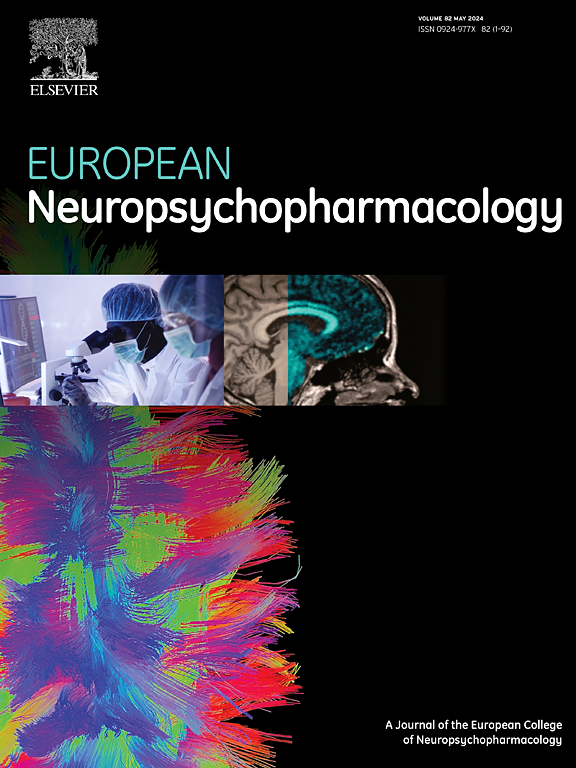Antipsychotic drug dosing and study discontinuation in schizophrenia: A systematic review and dose-response meta-analysis
IF 6.7
2区 医学
Q1 CLINICAL NEUROLOGY
引用次数: 0
Abstract
Background
High discontinuation rates compromise the effectiveness of treatment regimens for schizophrenia, because consistent medication adherence is essential for the efficacy of antipsychotics. Understanding the relationship between antipsychotic doses and discontinuation rates is important. This study explores this relationship to identify doses that maximize treatment adherence and minimize discontinuation.
Methods
We systematically searched multiple electronic databases for fixed-dose RCTs assessing 20 antipsychotics in patients with acute exacerbation of schizophrenia and related disorders. We analyzed dose-response relationships using a one-stage dose-response meta-analysis within a frequentist framework, employing restricted cubic splines to model the relationships. The primary outcome was discontinuation for any reason, and secondary outcomes were discontinuation due to inefficacy and side effects.
Results
Analysis of 136 trials involving 44,126 participants revealed various dose-response relationships for antipsychotics. For the primary outcome, all-cause discontinuation, amisulpride, cariprazine, olanzapine (Zyprexa), and quetiapine demonstrated U-shaped curves, indicating optimal dosing thresholds where further increases in dosage led to heightened discontinuation rates, possibly due to side effects. Aripiprazole, asenapine, brexpiprazole, clozapine, paliperidone, and risperidone (Risperdal) had plateaus, suggesting no additional benefit from increasing doses beyond specific points. For haloperidol, iloperidone, lumateperone, lurasidone, sertindole, and ziprasidone, the dose-response curves did not reach a plateau within the examined doses. Inefficacy discontinuation curves were similar to total discontinuation. Most discontinuation for side-effects curves showed sharp increases in side-effects associated with higher doses.
Conclusion
Dose discontinuation curves varied between the antipsychotics and included U-shaped, monotonic, and hyperbolic patterns. Future studies should consistently present disease-related and side-effect-related dropouts due to adverse events separately.
精神分裂症的抗精神病药物剂量和研究中断:系统回顾和剂量-反应荟萃分析
背景:高停药率降低了精神分裂症治疗方案的有效性,因为持续的药物依从性对抗精神病药物的疗效至关重要。了解抗精神病药物剂量和停药率之间的关系是很重要的。本研究探讨了这种关系,以确定最大限度地坚持治疗和最大限度地减少停药的剂量。方法系统检索多个电子数据库的固定剂量随机对照试验,评估20种抗精神病药物在精神分裂症及相关疾病急性加重患者中的应用。我们在频率学框架内使用单阶段剂量-反应荟萃分析分析剂量-反应关系,采用限制三次样条对关系建模。主要结局是因任何原因停药,次要结局是因无效和副作用停药。结果对涉及44126名受试者的136项试验的分析揭示了抗精神病药物的各种剂量-反应关系。对于主要结局,全因停药、氨硫pride、卡吡嗪、奥氮平(再普雷沙)和喹硫平呈u形曲线,表明最佳剂量阈值,剂量进一步增加导致停药率升高,可能是由于副作用。阿立哌唑、阿塞那平、布雷哌唑、氯氮平、帕利哌酮和利培酮(利培酮)均有平台期,表明增加剂量超过特定点后没有额外的益处。氟哌啶醇、依哌啶酮、氟哌啶酮、鲁拉西酮、塞替多尔和齐拉西酮的剂量-反应曲线在检测剂量内没有达到平台。无效停药曲线与完全停药曲线相似。大多数因副作用而停药的曲线显示,随着剂量的增加,副作用急剧增加。结论不同抗精神病药物的停药曲线不同,可分为u型、单调型和双曲线型。未来的研究应一致地分别显示由于不良事件导致的疾病相关和副作用相关的退出。
本文章由计算机程序翻译,如有差异,请以英文原文为准。
求助全文
约1分钟内获得全文
求助全文
来源期刊

European Neuropsychopharmacology
医学-精神病学
CiteScore
10.30
自引率
5.40%
发文量
730
审稿时长
41 days
期刊介绍:
European Neuropsychopharmacology is the official publication of the European College of Neuropsychopharmacology (ECNP). In accordance with the mission of the College, the journal focuses on clinical and basic science contributions that advance our understanding of brain function and human behaviour and enable translation into improved treatments and enhanced public health impact in psychiatry. Recent years have been characterized by exciting advances in basic knowledge and available experimental techniques in neuroscience and genomics. However, clinical translation of these findings has not been as rapid. The journal aims to narrow this gap by promoting findings that are expected to have a major impact on both our understanding of the biological bases of mental disorders and the development and improvement of treatments, ideally paving the way for prevention and recovery.
 求助内容:
求助内容: 应助结果提醒方式:
应助结果提醒方式:


